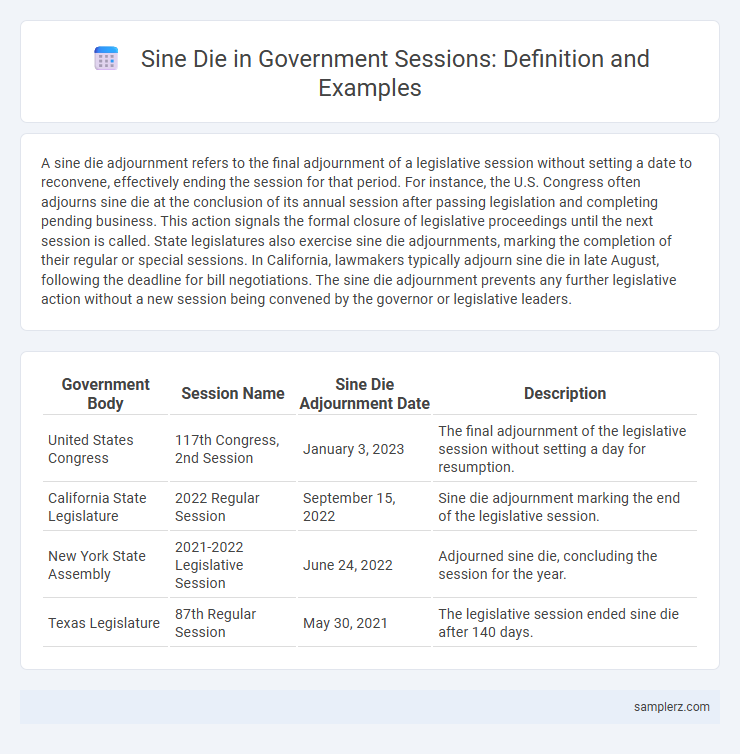A sine die adjournment refers to the final adjournment of a legislative session without setting a date to reconvene, effectively ending the session for that period. For instance, the U.S. Congress often adjourns sine die at the conclusion of its annual session after passing legislation and completing pending business. This action signals the formal closure of legislative proceedings until the next session is called. State legislatures also exercise sine die adjournments, marking the completion of their regular or special sessions. In California, lawmakers typically adjourn sine die in late August, following the deadline for bill negotiations. The sine die adjournment prevents any further legislative action without a new session being convened by the governor or legislative leaders.
Table of Comparison
| Government Body | Session Name | Type of Adjournment | Date | Reason for Sine Die Adjournment |
|---|---|---|---|---|
| United States Congress | 116th Congress, 2nd Session | Sine Die | January 3, 2021 | End of legislative session before new Congress convenes |
| California State Legislature | 2019-2020 Regular Session | Sine Die | November 30, 2020 | Conclusion of legislative activities for the session |
| Texas Legislature | 87th Regular Session | Sine Die | May 27, 2021 | Official end of session after 140 days |
| New York State Senate | 2023 Legislative Session | Sine Die | June 21, 2023 | Completion of legislative agenda for the year |
Understanding the Meaning of Sine Die in Government Sessions
Sine die is a Latin term meaning "without a day," used in government to signify the final adjournment of a legislative session with no appointed date for resumption. This closure officially ends the session's work, preventing any further meetings until a new session is convened by the governing authority. Understanding sine die is crucial for recognizing when legislatures conclude their duties and transition to the next legislative cycle.
Historical Examples of Sine Die Adjournments
The 1948 Democratic National Convention famously adjourned sine die after intense debates over civil rights, marking a pivotal moment in U.S. political history. Another notable example occurred in 1973, when the U.S. Congress adjourned sine die amid the Watergate scandal, reflecting deep partisan divisions. These adjournments without assigning a day for resumption underscore critical turning points where legislative bodies conclude sessions indefinitely due to political or social impasses.
Sine Die in the U.S. Congress: Notable Cases
Sine die adjournment in the U.S. Congress marks the final adjournment of a session without setting a date to reconvene, ending all pending legislative activity. Notable cases include the 1995 sine die adjournment during a government shutdown when Congress ended the session amid budget disputes. This procedural move effectively concluded legislative business until the next session convened.
Sine Die in State Legislatures: Key Instances
Sine die adjournment marks the final conclusion of a legislative session without setting a date to reconvene, effectively ending all pending business. Notable examples include the California State Legislature's 2020 sine die adjournment amid the COVID-19 pandemic, which halted regular legislative activity indefinitely. In Texas, the legislature's sine die session in 2019 underscored the end of a 140-day session, emphasizing the constitutional limits on legislative time.
The Legal Implications of Sine Die Adjournment
Sine die adjournment marks the final conclusion of a legislative session without scheduling a date to reconvene, legally terminating all pending business and bills. This procedural action prevents further legislative actions during the interim, requiring any unfinished legislation to be reintroduced in the next session. Legal implications include the extinguishment of committee authority over unresolved measures and the cessation of legislative jurisdiction until the next convening.
Sine Die at International Parliamentary Sessions
Sine die adjournment in international parliamentary sessions signifies the final adjournment without scheduling a subsequent meeting, effectively concluding the session. This practice is commonly observed in bodies such as the United Nations General Assembly and the Inter-Parliamentary Union, marking the end of legislative activities until the next convening. The sine die adjournment impacts diplomatic negotiations and treaty discussions by officially closing the current session's agenda.
Impact of Sine Die Adjournment on Pending Legislation
Sine die adjournment terminates the legislative session without setting a date to reconvene, causing all pending bills to expire unless reintroduced in the next session. This procedural action directly impacts the legislative agenda by halting progress on unfinished legislation, potentially delaying critical policy decisions and reforms. Lawmakers must strategically prioritize bills before sine die to ensure essential measures are enacted before adjournment.
Noteworthy Sine Die Sessions in Constitutional History
The U.S. Congress adjourned sine die on March 3, 1875, marking the end of the 43rd Congress with significant implications for Reconstruction-era legislation. Another noteworthy sine die session occurred on December 21, 1933, concluding the 73rd Congress during the implementation of New Deal reforms. These sessions demonstrate how sine die adjournments serve as constitutional milestones, finalizing legislative workflows without scheduling a reconvening date.
Sine Die and the End of Legislative Terms
Sine die marks the final adjournment of a legislative session without setting a day to reconvene, effectively ending all pending legislative business. This procedural closure ensures that any bills not passed by the sine die adjournment must be reintroduced in the next session. Legislators use sine die adjournment to formally conclude the legislative term, allowing for transition and preparation for future sessions.
Recent Examples of Sine Die in Government Proceedings
Recent examples of sine die adjournments include the U.S. Congress concluding the 117th legislative session on January 3, 2023, officially ending all pending legislative business without setting a date to reconvene. State legislatures, such as the California State Assembly, often adjourn sine die after completing their annual budget approvals and critical lawmaking tasks, marking the final adjournment for that session. These adjournments signify the formal closure of legislative actions until the next scheduled session begins.

example of sine die in session Infographic
 samplerz.com
samplerz.com